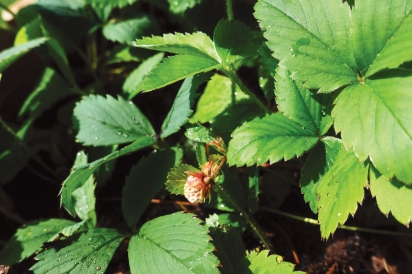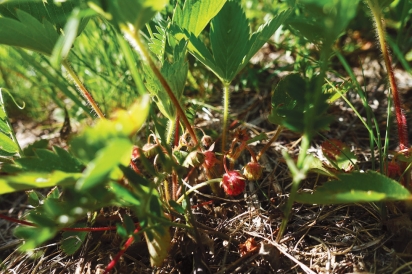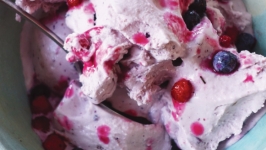Eating Wild: Patience and the Pursuit of Wild Strawberries
When it comes to certain wild plants, a successful day of foraging is simply a matter of showing up. Dandelion greens in the springtime, brambleberries and sumac in the summer, rosehips in the fall — as long as you wear the correct gear, bring your harvest bag or basket, and set aside some time, you can come home with a respectable amount of beautiful found food, ready to be cooked into your next delicious meal or stored in your pantry.
And then there are wild strawberries.
Tiny. Fleeting. Brilliant little gems bursting with flavor. This past year I spent more hours than one might consider reasonable searching out patches of these ruby morsels and ended up with less than a cup of fruit for my efforts. But oh, was it worth it.
Both Alice Waters and Robin Wall Kimmerer — two of my favorite writers on the subjects of garden-fresh meals and edible plants — describe the role wild strawberries played early on in their connection to wild food. In my own foraging life, wild strawberries, or non-cultivated members of the Fragaria genus, are one of the first wild plants I can remember identifying and harvesting, more than a decade ago on a cross-country road trip through some of the nation’s most beautiful wild spaces.
I’d only recently started learning about the abundant wild edible plants in North America when I spotted a patch of the vibrant, easily identified little berries in a meadow in Montana. And after that first spy it seemed like wild strawberries were everywhere I traveled: across the northwestern United States, the southern edge of Canada, and all the way back to my East Coast home. Though they were common, it was rare to find them in abundance, and I harvested berries in numbers I could sometimes count on my fingers and toes. The sweet finds were stirred into pancake batter and cooked into a campfire breakfast, eaten as a mid-hike snack, or mashed at the bottom of a tin cup and mixed with something boozy for a post-dinner drink. They offered a bit of fresh and summery flavor in a world of prepackaged dry meals and less-than-thrilling canned goods.
All these years later, coming across a patch of these perfect little berries at just the right moment in the season has never stopped feeling a bit like a gift.
Identifying wild strawberries is really just a matter of becoming familiar with their common garden counterparts, and learning to recognize the signature characteristics that distinguish these plants from their neighbors. Wild varieties of Fragaria look nearly identical to the cultivated varieties you see at farms and garden stores, but with each corresponding plant part presenting at a mere fraction of the size. There is that same toothed, three-leaf — or trifoliate — structure, the same red-tinged runners that spread low along the ground searching for a place to reroot, and the same five-petaled white flowers with sunny yellow centers. (A potential lookalike to the wild strawberry, the mock strawberry, has a yellow flower instead of a white one. The mock strawberry is also non-toxic, but make sure you do your due diligence when going through your identification steps to rule out this different plant.)
The miniature fruit of the wild strawberry starts out white, transforming before you can blink into that perfect fire-engine red that broadcasts, both to us and to the many other animals that share our land, that it is at the perfect stage for eating. Depending on the wild variety you stumble upon, seeds may either be embedded in the fruit’s surface or raised up like little goosebumps. Botanically speaking, these tiny “seeds” are in fact the true fruit of the strawberry plant, but that’s a scientific rabbit hole to fall down another day. Most of the wild strawberries I discover range in size from smaller than my pinky nail to just larger than my thumbnail, with the latter constituting a real find in my book. Regardless of size, they all pack that tart-but-sweet flavor we search for in the very best cultivated strawberries.
In our East Coast home, wild strawberries really can be found just about everywhere that is green and lush: in open meadows under full sun, along the edges of the woods where the canopy allows only dappled light to shine through, and even in the shadier parts of some deciduous woods. I often find the most easily harvested berries growing near sun-warmed boulders in open fields. Ripe wild strawberries can generally be found earlier in the year than other wild berries, and you could potentially find berries ready for harvest beginning as early as April or May depending on exactly where you live and the weather that season.
If you manage to find a ready-to-pick patch somewhere away from high foot traffic and harmful pesticides and happen upon your discovery before another woodland dweller has eaten them all, you’ll need to be gentle in your harvesting technique. Like the best-tasting cultivated strawberries grown on local farms and snatched up from roadside stands, wild strawberries are extremely delicate. They will bruise easily, and as soon as they do they will become soft and begin to go bad. Even just letting them sit on top of one another in a bag or basket will likely lead to a mushy red mess, so pick and store with care. And, as always with foraging, remember that you are sharing these berries with many flying and crawling creatures, so leave some of what you find behind.
So, what is the best way to enjoy these tiny treats? Since it’s unlikely you’re going to be harvesting in large quantities, I recommend eating them slowly, right when you pick them, while thinking deep thoughts. Share them with your companions. Talk about all the incredible and unlikely ways plants have figured out how to grow and thrive. But if you insist upon preparing them in some way, I’d suggest that you make cocktails and ice cream.
A classic gin and tonic or gimlet with muddled wild strawberries is fantastic, as is a fizzy glass of Prosecco or other bright sparkling wine. Tequila is also a great partner to the wild strawberry. If you’re looking for something alcohol-free, simply mix some berries and a squeeze of lemon with sparkling water. Freezing a few berries as soon as you pick them and making a batch of this summery drink in the middle of the winter is sure to put a smile on your face.
As for ice cream, wild strawberries make a great flavor on their own, or used in combination with a wide variety of wild fruit and many different types of garden herbs. Blueberries, raspberries, blackberries, and mulberries all pair well with strawberries in ice cream. Basil, fennel, and particularly thyme are also lovely additions in small amounts. You can either simmer everything in your dairy base together and blend it smooth before processing in an ice cream maker, or add some fruit in later, so you get bites of whole berries as you go. I will often macerate the berries by covering them in a bit of sugar and letting them sit for ten to thirty minutes before using them. This sweetens the berries and allows them to release some of their juices, creating a delicious syrup that can be added into or tossed on top of vanilla ice cream.
When it comes to using the rest of the strawberry plant, you can steep wild strawberry leaves as an herbal tea infusion just like you can with cultivated strawberry leaves. The soothing drink has been consumed for centuries as a digestive tonic and is mild tasting enough to be added into your favorite herbal tea blends.
Wild strawberries may never play as prominent a role in your foraging rotation as red clover flowers, mint leaves, or chicory roots, but their lack of abundance makes them all the more special. So look carefully, walk gently, and savor these sweet little bits of sunshine whenever you find them.
NOTE: Always consult with trusted experts and refer to foraging books and field guides for 100% positive plant identification before consuming any wild plant. As with harvesting any wild plant, and particularly ones that grow in commonly-sprayed areas, take particular care to collect from spaces you know to be chemical-free. Never pick any wild plant from protected spaces. Integrate new foods into your diet in small quantities to gauge any dietary and allergy sensitivities, and consult with a doctor if you have any questions or concerns about specific health issues or medication interactions.








